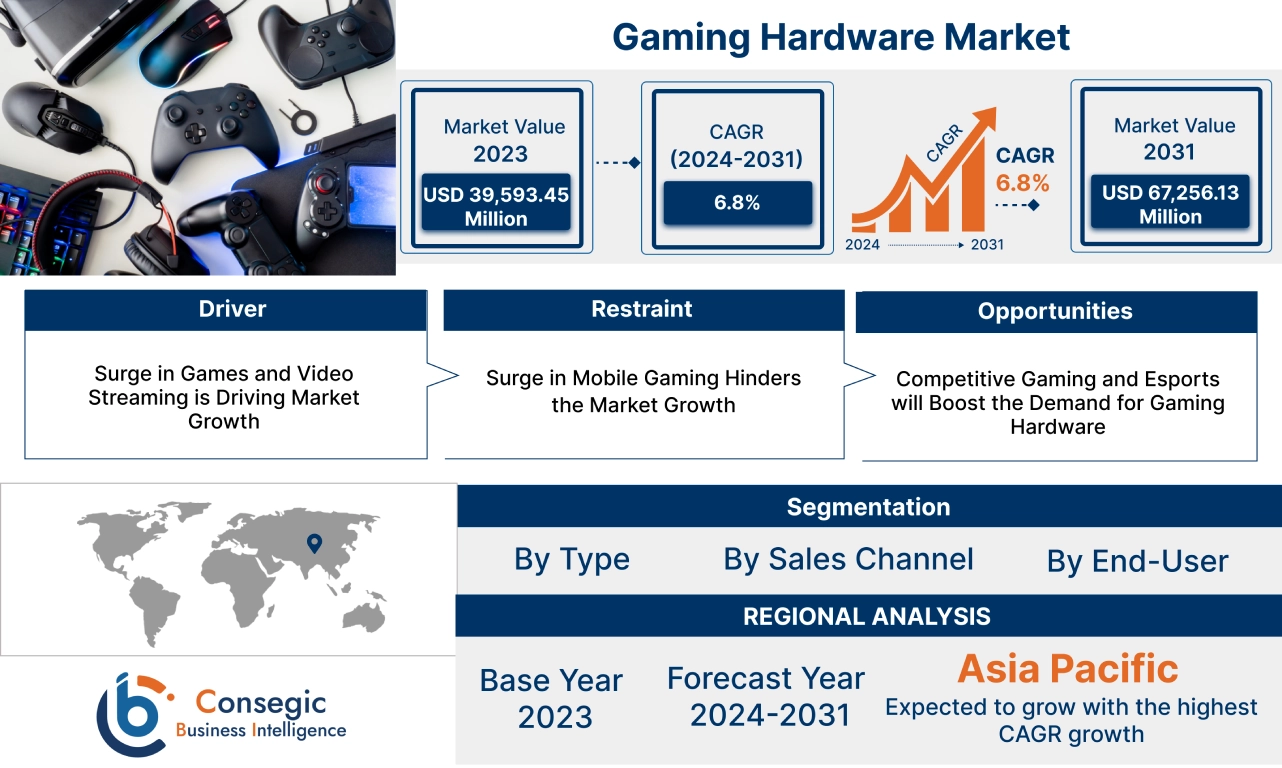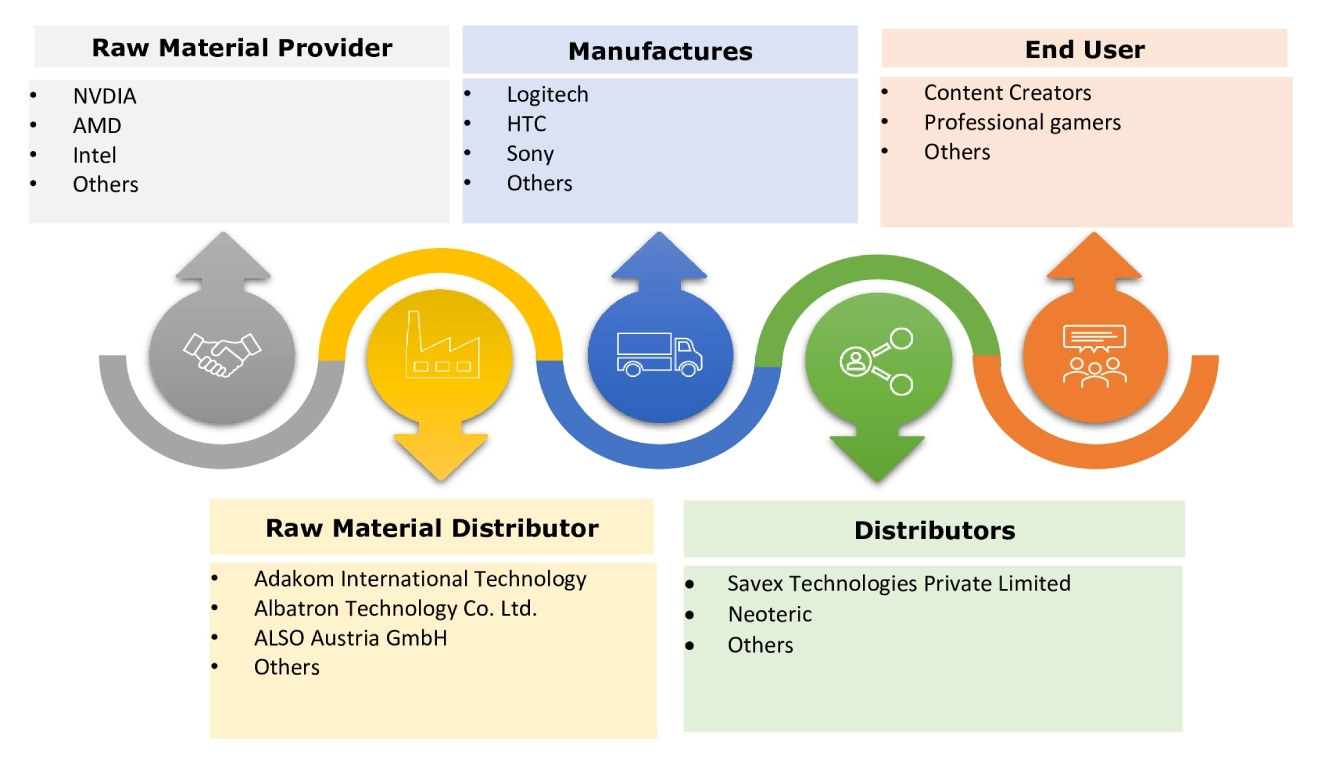Gaming Hardware Market Scope & Overview:
Gaming hardware signifies the physical components of a computer known as peripherals or consoles required for executing games. The primary types include gaming accessories, and gaming consoles, among others. They offer a range of benefits including high frame rates, smooth gameplay, better graphics, and more. The aforementioned benefits are major determinants for increasing their deployment in gamers, programmers, and others.
Gaming Hardware Market Size:
The Gaming Hardware Market is projected to reach over USD 67,256.13 million by 2031, growing from USD 41,599.25 million in 2024, at a CAGR of 6.8% from 2024 to 2031.
For instance, in June 2024, Logitech G unveiled the G515 LIGHTSPEED TKL Wireless Gaming Keyboard. This keyboard features a sleek, contemporary design, and provides cutting-edge technology and superior performance.
Gaming Hardware Market Insights:
Gaming Hardware Market Dynamics - (DRO) :
Key Drivers:
Surge in Games and Video Streaming is Driving Market Growth
The boom in gaming and video streaming is propelling the gaming hardware market growth due to increased consumer demand for high-quality gaming experiences. This surge has led to a heightened demand for advanced hardware as gaming evolves from a casual pastime to a serious pursuit and even a profession.
The emergence of live and on-demand game streaming has led to a new wave of content-centric consumers that require advanced gaming technology.Additionally, rapid advancements in gaming technology and the advent of cloud gaming have further fueled the gaming hardware market demand.
- In April 2022, ASUS Republic of Gamers (ROG) announced a strategic partnership with SRO Motorsports America to enhance GT Racing and next-gen racing simulators. Their industry-leading reputation complements SRO's other tech partners like AWS and CrowdStrike, many racers are users of ASUS ROG hardware for their sim training.
Therefore, advancements in games and video streaming are driving the growth of the gaming hardware industry.
Key Restraints :
Surge in Mobile Gaming Hinders the Market Growth
Mobile gaming is often favored over PC gaming due to its portability, allowing games to be played anywhere and anytime. The ease of access and simplicity of mobile games make them attractive to casual gamers.
Additionally, mobile gaming is generally more cost-effective, considering the lower costs of both the devices and the games themselves. The convenience of using a single device for multiple purposes, including gaming, and others. The quality of mobile games has significantly improved due to technological advancement, making them more engaging for players. Furthermore, the success of multiplayer mobile games has drawn a larger audience to mobile gaming.
- In August 2023, according to the analysis, Nostra, one of Asia's largest gaming platforms for mobile gaming saw a 30% rise in its monthly active users and a 50% increase in games played per session.
- The platform also experienced a threefold increase in both user's time spent on live streams and the daily active user base for live tournaments. Nostra plans to add 600 new casual and hyper-casual games across 15 categories and invites global game developers and studios to publish games on their platform.
Therefore, the surge in mobile gaming due to the portability of mobile devices and high-end features and processors making it a good alternative for game play on the go is restraining the gaming hardware market.
Future Opportunities :
Competitive Gaming and Esports will Boost the Demand for Gaming Hardware
The demand for these hardware is on the rise due to competitive gaming and the rise of esports. By purchasing gaming hardware, professional gamers and individuals who are passionate about gaming meet their increased need for high-power machines. They provide the necessary processing power for games such as League of Legends, Counter-Strike: Global Offensive, and Fortnite, which are taking over the world.
- In May 2024, GIANTX, a multinational esports organization, renewed its partnership with HSBC UK. The collaboration aims to promote financial discipline among youths via different programs and events. In the next year, the aim is to achieve better financial literacy levels for gamers, esports enthusiasts, and wider society and support professional players and content creators within the organization.
Hence, the rise of competitive gaming and esports is anticipated to promote gaming hardware market opportunities during the forecast period.
Top Key Players & Market Share Insights:
The gaming hardware market is highly competitive with major players providing gaming accessories to the national and international markets. Key players are adopting several strategies in research and development (R&D), product innovation, and end-use launches to hold a strong position in the gaming hardware market. Key players in the gaming hardware industry include-
- Logitech (Switzerland)
- Razer Inc. (U.S)
- Nintendo (Japan)
- Sony Group Corporation (Japan)
- HTC Corporation (Taiwan)
- Anker (China)
- A4TECH (Taiwan)
- Venom (UK)
- NVIDIA (U.S)
- Corsair Memory, Inc. (U.S)
- Dell Inc. (U.S)
Gaming Hardware Market Segmental Analysis :
By Type:
Based on the type, the market is segmented into gaming accessories, gaming consoles, and gaming PCs & laptops.
Trends in the type:
- The introduction of Super GPUs, which offer around 15% higher performance at the same price as the original models.
- The emergence of high-performance graphics cards at more affordable prices is influencing the demand.
The gaming PC & laptops segment accounted for the largest revenue share of 40.27% in 2023.
- A gaming PC & laptop includes elements like high-performance components such as CPU, graphics card, and others. They are designed specifically for an immersive and smooth gaming experience.
- Additionally, they offer a range of advantages such as improved gaming experience, efficient cooling systems, customization, enhanced performance, and others.
- Moreover, they include powerful processors, advanced graphics cards, ample RAM and storage, efficient cooling systems, and high-resolution displays for an immersive gaming experience.
- In December 2023, MSI launched its latest flagship gaming laptop, the Titan 18 HX. This device features an 18" 4K/120Hz Mini LED display, positioning it as the most premium laptop display currently available.
- Therefore, the high-performance components in gaming PC & laptop are driving the gaming hardware market trends.
The gaming accessories are anticipated to register the fastest CAGR during the forecast period.
- A gaming accessory involves components such as computer or gaming peripherals hardware. They are utilized to enhance the gameplay experience such as headphones, keyboard, microphone, mouse, controller, and more.
- Additionally, gaming accessories offer numerous advantages, such as enhancing gameplay, improving performance, and providing a more immersive and enjoyable experience.
- In February 2024, PowerA introduced Fortnite-themed gaming equipment, in partnership with Epic Games. PowerA's first collection; PowerA x Fortnite showcases cute looks imitating Peely and Midas from Fortnite that's optimized for Nintendo Switch and Xbox Series X|S platforms.
- Therefore, the market analysis concludes that a wide variety of gaming accessories is anticipated to boost the market opportunities during the forecast period.
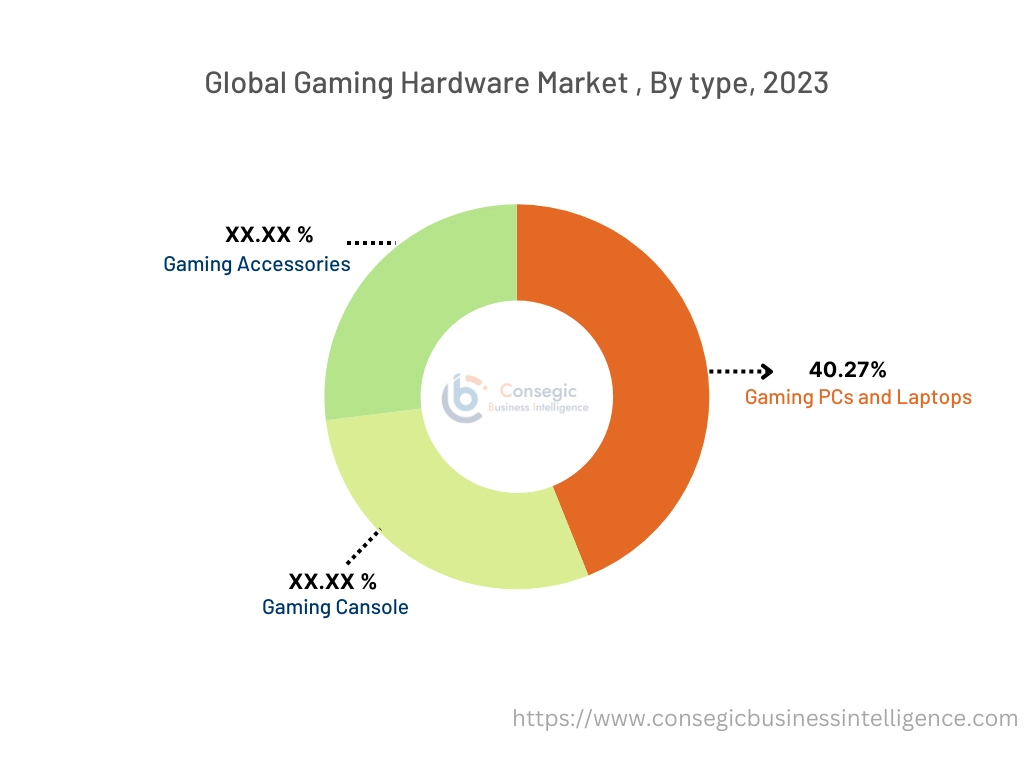
By Sales Channel:
Based on the sales channel, the gaming hardware market is segmented into online, retail stores, authorized resellers and distributors, custom PC builders, and enterprises.
Trends in the sales channel:
- The growing e-commerce platforms like Amazon, eBay, and others are providing an added advantage for the sale of hardware such as mouse, keyboards, displays, joysticks, and other hardware.
The online segment accounted for the largest revenue in the year 2023 and is anticipated to register the fastest CAGR during the forecast period.
- The analysis shows that online shopping is increasingly becoming the preferred choice for purchasing this hardware. This is due to the convenience they offer, allowing customers to shop at any time and from anywhere.
- They provide a broad array of products from various brands, enabling customers to compare and select the best option. Moreover, detailed product specifications, reviews, and ratings on these platforms assist customers in making informed decisions.
- Additionally, they often have return and exchange policies, enhancing the shopping experience. Online platforms frequently offer additional discounts, making products more affordable.
- As per the analysis, when businesses sell directly to consumers through their online stores, they can control product displays and have comprehensive access to customer data.
- In December 2023, Vertux, a leading lifestyle gaming company from Taiwan, entered the Indian market in an exclusive partnership with Amazon India. The company's mission is to enhance the gaming experience by offering professional-grade gaming products such as keyboards, headphones, mouse, mousepads, and other accessories.
- Therefore, the convenience, return, and exchange policies, and others associated with the online segment are driving the market.
By End-User:
Based on the end user, the market is segmented into professional gamers, content creators, programmers, and others.
Trends in the end-user:
- The availability of upgraded displays and high-definition monitors is influencing the market.
- There's a growing trend among gamers towards using sophisticated gaming consoles and accessories.
Professional gamers accounted for the largest revenue in 2023 in the overall gaming hardware market share and are anticipated to register the fastest CAGR during the forecast period.
- Gaming hardware is of paramount importance to professional gamers. High-performance hardware ensures optimal gameplay with smoother graphics and higher frame rates, which are critical in competitive gaming. It also offers reliability, capable of enduring lengthy gaming sessions without technical glitches.
- Additionally, high-resolution monitors and advanced audio systems contribute to a more immersive gaming experience, aiding focus and engagement.
- Moreover, the customizability of gaming hardware allows players to tweak settings to align with their personal preferences and gaming style.
- In November 2023, MSI provided 80 high-end gaming PCs, 160 G253PF game monitors, and Raider GE68 HX 13V gaming laptops for real-time commentary and broadcast as PGC's(PUBG Global Championship) official gaming partner.
- Therefore, gaming hardware for professional gamers is boosting the market trend during the forecast period.
Regional Analysis:
The regions covered are North America, Europe, Asia Pacific, Middle East and Africa, and Latin America.
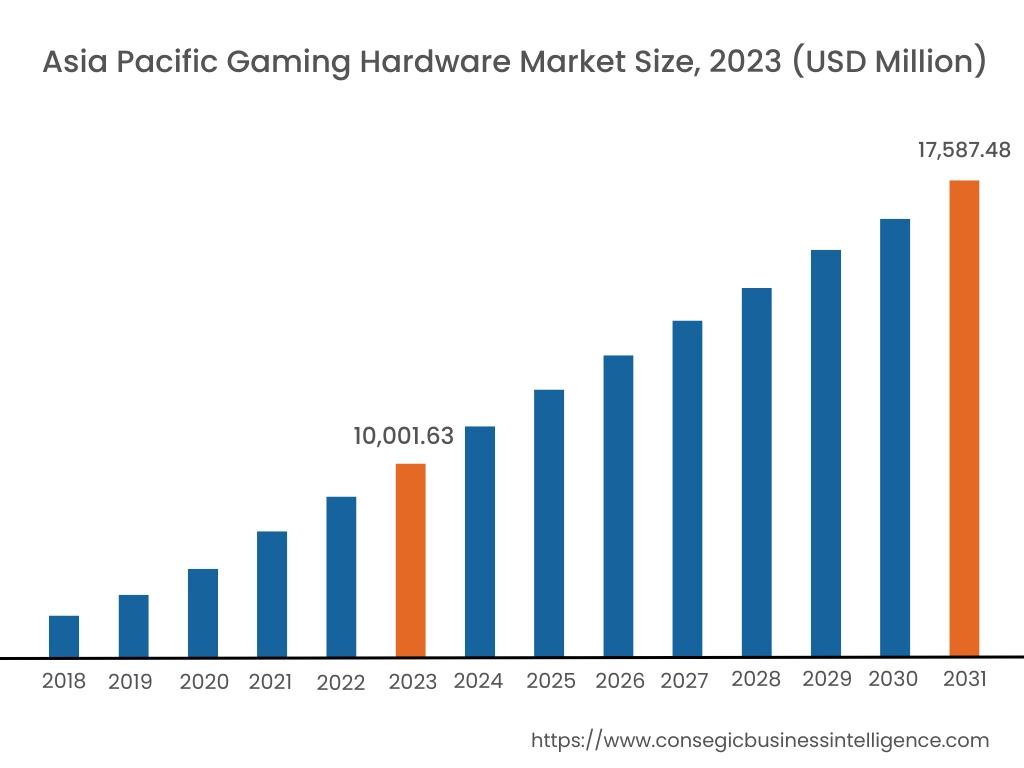
North America is estimated to reach over USD 23,109.21 Million by 2031 from a value of USD 13,600.68 Million in 2023 and is projected to grow by USD 14,290.01 Million in 2024. The gaming hardware market growth is mainly driven by its deployment in esports events.
- In April 2024, Acer launched its new products Acer Nitro 14 and Acer Nitro 16 gaming laptops created with AMD Ryzen 8040 Series processors powered by Ryzen AI technology.
Furthermore, analysis shows that factors including technological advancement in processors, displays, and growing gamer culture are projected to drive the market in North America during the forecast period.
Asia Pacific region was valued at USD 10,001.63 Million in 2023. Moreover, it is projected to grow by USD 10,539.14 Million in 2024 and reach over USD 17,587.48 Million by 2031. Out of this, China accounted for the maximum revenue of 37.1 % in the overall gaming hardware market share.
The growing gaming culture offers lucrative growth prospects for the market. Additionally, the evolution of esports and mobile gaming is driving the gaming hardware market trend.
- In January 2024, CyberPowerPC a gaming PC company based in California, ventured into the Indian market via a joint venture with the Indian company Creative Newtech. The company is set to launch its range of gaming rigs and gaming configurators in India.
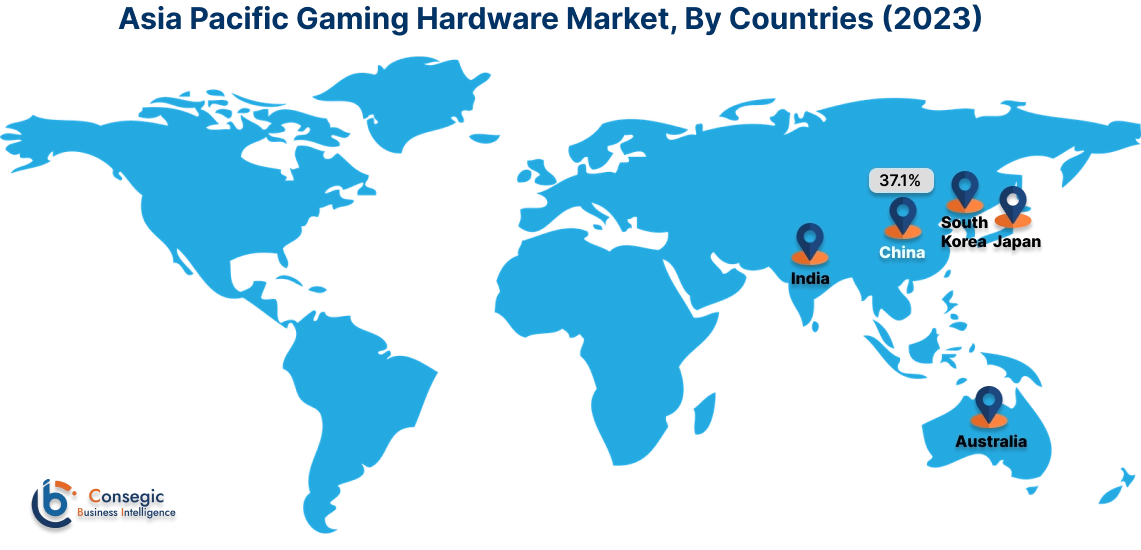
As per the gaming hardware market analysis, Europe is anticipated to witness substantial evolution that is backed by the increasing popularity of eSports and VR gaming, consumer preference for high-quality hardware, and a large customer base with a strong gaming culture. Companies invest in innovative technologies to cater to the surging need across the region.
The gaming hardware market in the Middle East & Africa is poised for moderate growth, driven by factors such as increased smartphone penetration and improved internet connectivity broadening the gamer base, also the rising youth population fueling gaming need, especially in countries like the UAE, Turkey, and South Africa.
The rising internet penetration and growing 5G trend in countries including Brazil, Argentina, and Mexico is depicting the cumulative expansion of the gaming hardware market in the Latin American Region.
Gaming Hardware Market Report Insights :
| Report Attributes | Report Details |
| Study Timeline | 2018-2031 |
| Market Size in 2031 | USD 67,256.13 Million |
| CAGR (2024-2031) | 6.8% |
| By Category |
|
| By Sales Channel |
|
| By End-User |
|
| By Region |
|
| Key Players |
|
| North America | U.S. Canada Mexico |
| Europe | U.K. Germany France Spain Italy Russia Benelux Rest of Europe |
| APAC | China South Korea Japan India Australia ASEAN Rest of Asia-Pacific |
| Middle East and Africa | GCC Turkey South Africa Rest of MEA |
| LATAM | Brazil Argentina Chile Rest of LATAM |
| Report Coverage |
|
Recent Industry Developments :
Product Launches
- In February 2024, Asus, launched the Asus ROG Zephyrus G14. It has AMD's Ryzen 9 8945HS processor, complemented by 16GB of RAM and an Nvidia GeForce RTX 4070 GPU. The laptop features a custom cooling system, a 14-inch OLED panel with 3K resolution, and comes pre-installed with Windows 11 Home. Additionally, it has a 73Wh battery for extended usage.
- In April 2024, LG Electronics unveiled UltraGearTM OLED gaming monitors, the monitor includes the 32-inch 4K gaming monitor (model 32GS95UE), a CES 2024 Innovation Award winner. This monitor features a new Dual Mode that enables gamers to effortlessly switch between 4K (3,840 x 2,160) at 240Hz and Full-HD (1,920 x 1,080) at 480Hz.
Mergers & Acquisitions
- In January 2022, Microsoft acquired Activision Blizzard in an all-cash deal valued at $68.7 billion, or $95.00 per share, which includes Activision Blizzard's net cash. Microsoft ranks as the world's third-largest gaming company by revenue, trailing Tencent and Sony.
- In June 2024, NZXT a top-tier company in PC gaming components, products, and prebuilt, is excited to declare a collaboration with FlyQuest, a leading esports organization. This partnership names NZXT as the "Official PC Partner" for FlyQuest's LCS, NACL, RED VALORANT, and RED CS2 teams, and their content creators. .
- In February 2023, Microsoft and NVIDIA entered into a decade-long partnership to make Xbox PC games available on NVIDIA's GeForce NOW cloud gaming service. This deal will allow gamers to stream Xbox PC games on various devices via GeForce NOW.
Key Questions Answered in the Report
How big is the gaming hardware market? +
Gaming Hardware Market size is estimated to reach over USD 67,256.13 Million by 2031 from a value of USD 39,593.45 Million in 2023 and is projected to grow by USD 41,599.25 Million in 2024, growing at a CAGR of 6.8% from 2024 to 2031.
What specific segmentation details are covered in the gaming hardware report? +
The gaming hardware report includes specific segmentation details for type, distribution channel, end-user, and region.
Which is the fastest segment anticipated to impact the market growth? +
In the type segment, gaming accessories are the fastest-growing segment during the forecast period due to their ability to enhance the gaming experience with equipment such as controllers, keyboards, mouses, and others.
Who are the major players in the gaming hardware market? +
The key participants in the gaming hardware market are Logitech (Switzerland), Razer Inc. (U.S), A4TECH (Taiwan), Nintendo (Japan), Sony Group Corporation (Japan), HTC Corporation (Taiwan), Venom (UK), NVIDIA (U.S), Corsair Memory, Inc. (U.S), Dell Inc. (U.S), Anker (China) and others.
What are the key trends in the Gaming Hardware Market? +
The gaming hardware market is being shaped by several key trends including the launch of super GPUs which enhance performance, graphics cards available at affordable prices, displays, and high-definition monitors.
